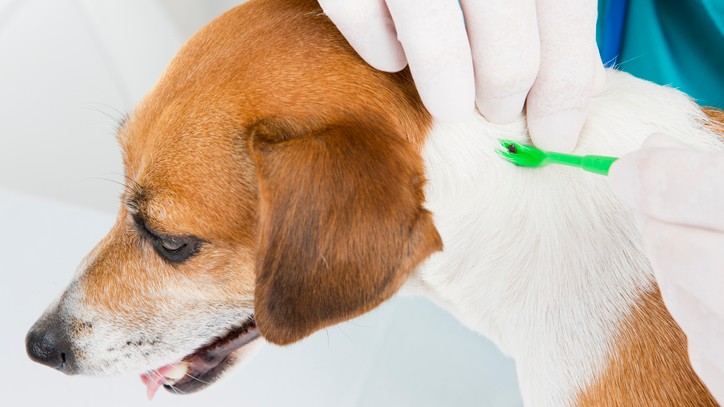A Vet’s Guide to Lyme Disease in dogs
The longer Lyme disease in dogs goes undetected, the poorer the outcome, so find out all you need to know

Lyme disease in dogs is an illness caused by the bacteria Borrelia burgdorferi, which is spread by ticks. The disease can cause a variety of symptoms, which can be vague and easily confused with other illnesses. Symptoms may also take a while to show up after the tick bite has occurred.
The disease most commonly affects the joints, followed by the kidneys, so it can be very painful and can sometimes cause long-term issues. In very severe cases it can even be fatal. So the best treatment is definitely prevention! Be sure to check your dog for ticks after a walk and speak with your vet about the best flea and tick prevention for your dog.
Read more vets’ guides to common dog health problems:
What is Lyme Disease in dogs?
Lyme disease is a bacterial disease caused by the bacteria Borrelia burgdorferi. Hence the medical name for Lyme disease in dogs, which is ‘Borreliosis’. Lyme disease is a ‘tick-borne’ disease, which means the bacteria are passed on by an infected tick biting and feeding. The disease can occur in dogs, horses, people and rarely cats.
Lyme disease can be found in Europe, the USA and parts of Asia. In the UK infection can happen anywhere, but is more common in Scotland and the South East and South West of England. In the USA, Lyme disease is common in the north-eastern, upper midwestern, and West Coast states.
The bacteria travel around the body through the bloodstream and attack various tissues. The joints are the most commonly affected site, followed by the kidneys, resulting in variable symptoms. Unlike in humans, dogs don’t develop the classic bullseye rash around the site of the tick bite. Luckily, Lyme disease can often be successfully treated. However, in severe cases it can cause long-term issues such as joint pain and, rarely, can even be fatal.
How do dogs get Lyme Disease?
Dogs contract Lyme disease through an infected tick attaching and feeding on their blood. The bacteria are passed into the dog’s bloodstream during feeding. Infection can happen at any time, but the longer the tick feeds for the more likely that the bacteria will be transmitted. Research indicates that the tick needs to remain attached and feeding for 24 hours or more for infection to occur. Dogs are most likely to pick up ticks when walking in woodland, forests, long grass, bushes, or pasture where deer or ruminants graze.
Get the best advice, tips and top tech for your beloved Pets
Luckily, neither you nor your other pets can catch Lyme disease from an infected dog. However, you can catch Lyme disease through an infected tick so take care. Be sure to remove a tick from your pet as soon as you see them: from yourself and your dog! Ticks must be removed very carefully, in a particular way, so that the mouthparts aren’t left in. If you are at all unsure, it’s safest to have them removed by your vet (or GP, if they’re on you!).
Symptoms of Lyme Disease in dogs
The symptoms of Lyme disease can be very variable. Some dogs will be infected and yet show no symptoms. Symptoms can take weeks, or even months, to appear. Symptoms can also wax and wane, so a dog may appear to be on the mend but then deteriorate again. Dogs don’t develop the characteristic ‘bullseye’ rash that people do, so the disease can be harder to spot.
The symptoms of Lyme disease in dogs include:
- Lameness and/or stiffness
- Swollen joints
- Pain
- Fever
- Swollen lymph nodes (glands)
- Lethargy (lacking in energy)
- Lack of appetite
- Weight loss
- Drinking and urinating (weeing) more
- Sickness and diarrhoea
Of course, all of these symptoms can also be caused by other illnesses. Regardless of the cause, if your dog is showing any of these symptoms, then they need to be examined by a vet.
Your vet will take a detailed history, asking you questions about possible exposure to ticks and where you walk your dog. If your vet suspects Lyme disease, they can take a blood sample to test for the illness. The test looks for antibodies, which your dog may not start producing for weeks. So, they will also run some bloods and urine tests to rule out other illnesses and to see if there is any organ damage.
Treating Lyme Disease in dogs

There’s no NHS for pets. Veterinary care can be eye-wateringly expensive and most pets will need treatment for an illness or injury at some point in their life. It’s difficult to think about your animals being hurt or unwell, but you need to ask yourself: what would you do if you were faced with a vet bill for hundreds or thousands of pounds?
Lyme disease is caused by bacteria, so it is treated with antibiotics. Usually, a four-week course of antibiotics is needed, sometimes more. Pain relief is often also given in the initial stages of treatment, since the joints can be very painful. Dogs who are lame due to Lyme disease are sometimes described as looking like they are ‘walking on eggshells’.
In mild cases, treatment can be started at home. In moderate to severe cases, dogs may need to be hospitalised for supportive treatment. This means treating the symptoms and supporting the organs to recover while the treatment starts to work. This usually involves a fluid drip.
Luckily, treatment is often successful, and the dog makes a full recovery. Sadly, in more severe cases, the disease can cause long-term joint pain or kidney damage. In the most severe cases, if treatment is started too late or the kidneys are damaged, then Lyme disease can be fatal. Thankfully this is rare.
Tips on preventing Lyme disease in dogs
Lyme disease is a nasty illness, so prevention is definitely better than cure! Here are our tips on preventing Lyme disease in dogs:
Keep up to date with regular tick prevention
Use a product that repels or quickly kills ticks. This has the added benefit of reducing the chances of other tick-borne diseases too. There are many products on the market, in the form of collars, tablets, and spot-ons. Many of these are multi-purpose, working against fleas and other parasites too. Speak with your vet about the best product for your dog.
Check your dog daily for ticks
Of course, no preventative is 100% effective. So, you should also check your dog for ticks every 24 hours, especially if you’ve walked in at-risk areas. This should prevent ticks feeding for long enough to transmit infection. Remember ticks can be tiny! Carefully check all over; focusing around the ears, eyes, collar area, tail base, between the legs, armpits and between the toes.
Safely remove any ticks you find
If you do find any ticks, you can use a tick hook to carefully remove them. Slide the hook between the tick’s body and your dog’s skin and twist. It is important not to pull or crush! This can actually increase transmission by stressing the tick, causing it to release saliva and stomach contents. It’s a good idea to book an appointment with your vet or vet nurse to safely remove any ticks, since they will also be able to teach you how.
Boao Tick Removal Tool Kit $11.99
A comprehensive tick removal kit that includes three removal hooks, three types of stainless steel tweezers and onepiece stainless steel comb.
Vaccinate your dog against Lyme
There is a vaccination available, which stimulates the immune system to be able to respond to Borrelia. This can reduce the risk of infection, but not prevent it completely.
Final thoughts on Lyme disease in dogs
Lyme disease is a bacterial illness transmitted by ticks. Dogs are most likely to pick up ticks in wooded, bushy, or grassy areas. Lyme disease in dogs most commonly causes joint pain and fever. However, symptoms do vary. It is potentially a very serious illness, with long term consequences.
If your dog shows any of the symptoms listed here, contact your vet straight away. Remember, prevention is better than cure! Check your dog daily for ticks and speak with your vet about tick prevention.
Sarah-Jane Molier graduated in 2009 and has been enjoying life as a vet ever since. She currently works as Head Veterinarian in a small animal practice. Sarah-Jane particular enjoys internal medicine, alongside her managerial role. When not working in practice Sarah-Jane enjoys sharing her knowledge and helping pet parents by writing on a wide variety of animal health and medicine topics. In her spare time Sarah-Jane loves walking Nero (her rescue dog), gardening with her two young children and reading.


